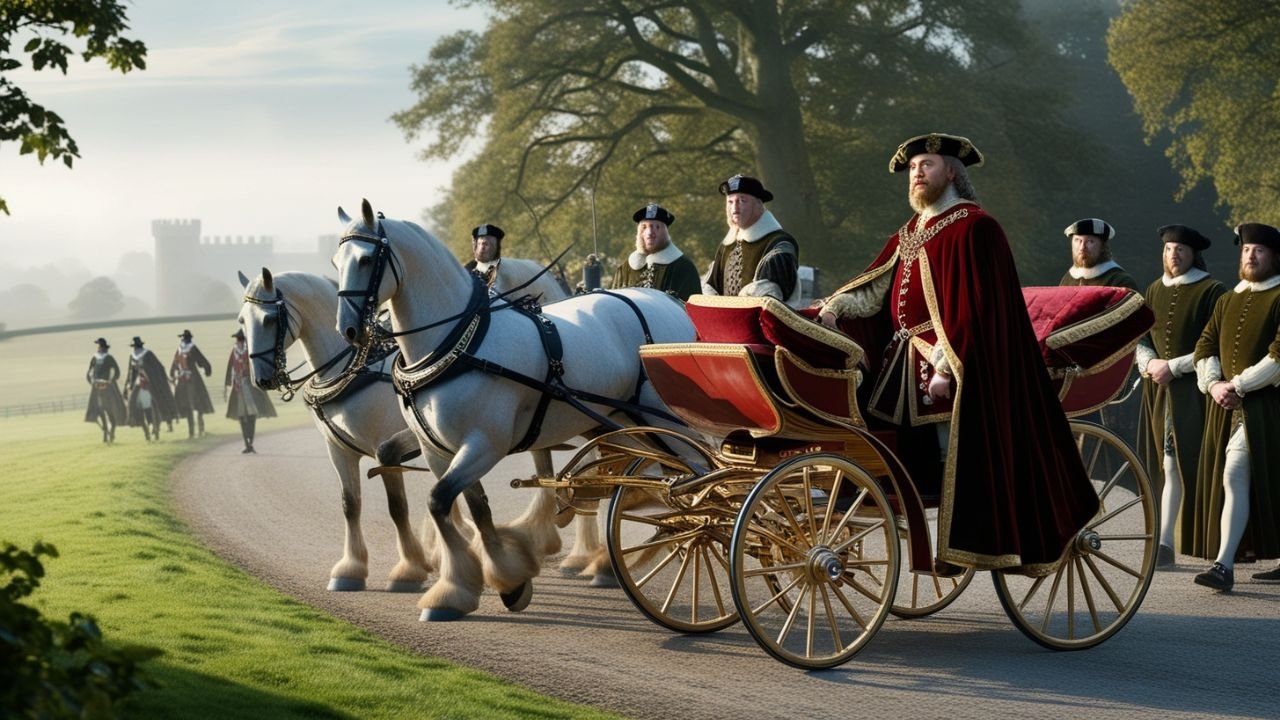King Henry VIII travels: King Henry VIII, one of England’s most iconic monarchs, led a life as fascinating as it was transformative. Known for his political maneuvering, religious reforms, and infamous marriages, Henry VIII’s travels played a significant role in shaping his reign and the Tudor era. These journeys were not merely for leisure but were deeply intertwined with diplomacy, governance, and the display of royal power.
The Context of Travel in Tudor England
During the Tudor period, travel was a challenging yet vital aspect of governance and diplomacy. For King Henry VIII, journeys were an opportunity to demonstrate his authority and connect with his subjects. Modes of transportation primarily included horses and carriages, with waterways being utilized where possible. These methods, though limited by today’s standards, were state-of-the-art for the 16th century.
Traveling as a monarch was no small feat. Henry VIII’s retinue often included hundreds of courtiers, servants, and soldiers. Logistics were intricate, involving the transport of food, supplies, and even furniture. These royal progresses, as they were known, were more than practical excursions; they symbolized the strength and stability of the crown.
king Henry viii Travels: Notable Domestic Travels
The Royal Progresses
One of the most notable aspects of King Henry VIII’s domestic travels was his royal progress. These journeys were designed to reinforce the king’s presence throughout his realm. A memorable example is his visit to the North after the Pilgrimage of Grace in 1536. This trip aimed to quell dissent and reaffirm loyalty following the rebellion against his religious reforms. The visit had a profound impact, strengthening the monarchy’s authority in the region.
Visits to Palaces and Hunting Lodges
Henry VIII was known for his love of luxury and leisure, which often influenced his travels. He frequented palaces like Hampton Court and Windsor Castle, using these locations as both residences and political centers. Hunting lodges also featured prominently in his itineraries, reflecting his passion for sport and outdoor pursuits. These trips allowed the king to balance governance with recreation, while also showcasing the grandeur of Tudor court life.
Travels Abroad
The Field of the Cloth of Gold (1520)
One of the most famous episodes in King Henry VIII’s travels abroad was the Field of the Cloth of Gold in 1520. This extravagant summit with King Francis I of France was held near Calais, England’s last continental possession. The event was a dazzling display of wealth and power, featuring elaborate tents, tournaments, and feasts. While the meeting did little to secure lasting peace, it underscored Henry’s ambition to assert England’s prominence on the European stage.
Trips to Calais
Calais held strategic importance during Henry VIII’s reign, serving as England’s foothold on the continent. The king’s visits to this port city were often tied to diplomatic efforts, including negotiations with European powers. These journeys highlighted Calais’s role as a critical asset in Tudor foreign policy, as well as its symbolic significance as a vestige of England’s medieval territorial ambitions.
The Logistics of Royal Travel
The logistics of King Henry VIII’s travels were as impressive as the journeys themselves. His entourage included a diverse array of individuals, from courtiers and military personnel to cooks and musicians. Planning these excursions required meticulous attention to detail, including securing accommodations and ensuring the smooth transport of goods.
Royal visits often had a significant impact on the towns and villages along the route. While the presence of the king and his retinue could bring economic benefits, such as increased trade, it also imposed considerable demands on local resources. Hosting the court was both an honor and a burden for these communities.
Cultural and Political Impact of His Travels
King Henry VIII’s travels were not merely physical journeys; they were acts of political theater. Domestically, they reinforced his image as a strong and accessible ruler, capable of uniting a diverse kingdom. Abroad, his journeys sought to bolster alliances and intimidate rivals, emphasizing England’s influence in European affairs.
The legacy of these travels is evident in the way they shaped Tudor diplomacy and governance. They reflected Henry’s dual role as both a national leader and a player on the international stage. Moreover, they provide modern historians with valuable insights into the priorities and challenges of his reign.
Conclusion
The travels of King Henry VIII reveal a monarch deeply engaged in the complexities of ruling a kingdom and navigating the turbulent politics of Renaissance Europe. Whether journeying to solidify his domestic authority or to make an impression abroad, Henry’s travels were a testament to his ambition and vision for England. These journeys, though centuries past, continue to captivate and inspire those who seek to understand the grandeur and intricacies of Tudor history.
For readers intrigued by the life and times of King Henry VIII, delving into his travels offers a unique perspective on his reign and the era he shaped so profoundly.
Read More:
Exploring Costco Travel: Deals, Benefits, and Tips for Smart Travelers
Additional Information about King Henry VIII Travels
